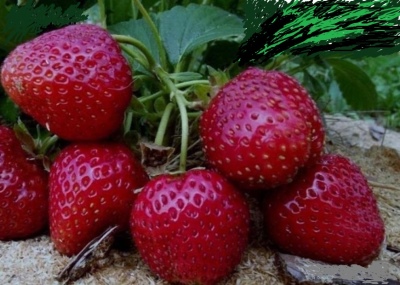
- Authors: Holland
- Name synonyms: Black Swan, Black Swan
- Taste: sweet, strawberry-cherry
- The size: very large
- Weight: up to 100 gr
- Yield rate: high
- Yield: up to 2 kg per bush
- Ripening terms: late
- Appointment: universal
- Description of the bush: tall, compact
The agricultural market today is replete with various types of strawberry crops. Late varieties have always been in great demand among gardeners. So, the Black Swan strawberry began to gain great popularity due to its high winter hardiness and productivity. Unusually beautiful, almost black, delicious berries can surprise even the most demanding gourmet.
Description of the variety
Dutch breeders have created an extraordinary large-fruited late strawberry variety. The culture is new, not very well known among gardeners. But it is considered one of the most promising for cultivation in the middle regions of Russia, the Urals, Western Siberia. The Black Swan bushes are graceful, the height is no more than 60 cm. The elongated, slightly corrugated dark green foliage proudly holds a large number of large white inflorescences in weight.
Ripening terms
Refers to late varieties. Fruiting is long lasting all summer. In good weather conditions, the fruits can be harvested in September.
Yield
Quite high yield. With proper care, up to 2 kg can be harvested from one bush. Lies well, does not flow during transportation. Ideal for both fresh and processed consumption.
Berries and their taste
The fruits of the Black Swan are very large. One berry in mass can reach 100 g. The dark cherry color of strawberries is close to black, looks like overripe. On a five-point tasting scale, the score is 5 points for an unusual sweet strawberry-cherry flavor.
It has a juicy and firm pulp with a pleasant mixed strawberry-strawberry aroma. Round-conical shape.
Growing features
Strawberries are demanding to care for. Especially it is necessary to monitor the moisture content of the soil. It should be moist, but without stagnant water. An excess of it can lead to the development of fungal diseases.
In hot weather, watering increases several times. During the flowering period, only drip irrigation is used. In the fall, watered several times a week. Moisturizing is carried out either early in the morning or late in the evening.
You cannot get a good harvest without fertilizers. For the development of foliage in the spring, potassium and nitrogen are required; for the ripening of berries in the summer, phosphorus is required.
The variety is drought-resistant, tolerates frosts up to 20 degrees, if the snow cover is abundant. But for better wintering, the plant must first be covered with straw, dry foliage. In one place, you can grow up to 7 years.




Site selection and soil preparation
The black swan prefers to grow on fertile soil (black soil, light loam). Heavy soil is pre-prepared, humus, sand, peat, wood ash are added.
The cultivar grows worst of all on loamy soil. The root system does not develop well on it, so getting a good harvest is extremely problematic.
The place should be as sunny as possible and protected from drafts. The lack of light greatly affects the taste of the berries (they become watery and sour).
Soil preparation consists in digging and loosening it, mineral (nitrogen) and organic (cow dung, bird droppings, compost) fertilizers are introduced. And also on the site you need to constantly remove weeds, which take valuable nutrients from the soil.
In crop rotation it grows better after cereals, marigolds, onions and garlic.

Pollination
The variety forms inflorescences of both sexes. Pollination occurs in a cross way.

One of the important techniques in strawberry care is feeding. Regular fertilization guarantees a rich harvest. There are several different ways to feed strawberries, and each of them is designed for a specific period of plant development. During flowering, fruiting and after it, feeding should be different.

Diseases and pests
The variety is distinguished by a fairly persistent immunity to fungal infections such as fusarium, late blight, anthracnose, as well as gray and white rot. But it is less resistant to powdery mildew, verticillosis, root and black rot. To avoid the development of diseases on plants, preventive treatment of the site should be carried out every season.

Strawberries are often subject to many dangerous diseases that can seriously undermine its condition. Among the most common are powdery mildew, gray mold, brown spot, anthracnose, and verticillosis. Before buying a variety, you need to inquire about its disease resistance.
Reproduction
It forms a few mustache, which creates certain difficulties in the preparation of planting material. And the older the bush, the fewer of them. Saplings are chosen strong, without signs of diseases, with a good root system.
The best time for disembarkation is autumn. In the southern and middle regions, it can be planted in spring, but the first harvest will not appear until July.
However, before you start planting bushes, you need to check the pH level. It should be neutral or slightly acidic.
Prepare holes, the distance between which is 50 cm, seedlings 30 cm. Before planting, each hole is watered abundantly, the roots are straightened and carefully placed in the hole. It is important to plant the bush correctly. The apical bud should not be covered with earth. If you deepen it too much, it can rot, and too much will lead to the death of the plant.
Around the bush, the earth is carefully compacted and watered. Be sure to mulch the soil. The next 3-4 weeks, the seedlings are watered abundantly, trying not to get water on the leaves. If the leaves are damaged during planting, they should be removed. Strawberries quickly restore green mass.



















































































